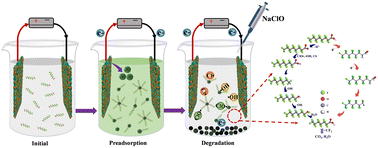Efficient preadsorption–degradation of PFOA in water by a NaClO-assisted electrocoagulation technique using an Fe/Ni foam electrode†
Abstract
Perfluorooctanoic acid (PFOA) has been extensively studied as a persistent organic pollutant due to its persistence, immunotoxicity, and bioaccumulation. In this research, Fe/Ni foam electrodes were used to remove PFOA from simulated and practical factory wastewater using the electrocoagulation (EC) technique. To improve degradation, NaClO was added to the EC system to complete the “preadsorption–degradation” reaction system (EC-NaClO). The removal of 100 mg L−1 PFOA (100 mL) reached 95.4% and defluorination was 68.5%. Although ClO˙, ˙OH, Cl˙, and electron transfer cannot directly attack PFOA molecules in this process, they do play important roles in reactions with the intermediate products. Based on the investigation of various driving forces, a PFOA adsorption mechanism on Fe flocs was proposed. The PFOA degradation mechanism was concluded based on the results of the quenching experiments and the contributions of various reactive species. According to the intermediates tested by HPLC-MS, two possible PFOA degradation pathways were proposed, and the results showed that PFOA was decomposed by losing –CF2– or –COO– units stepwise. The EC-NaClO process with the Fe/Ni foam electrode demonstrated efficient “preadsorption–degradation” and improved recyclability, implying that the EC-NaClO technique has high potential for efficient and complete removal of PFOA from industrial PFOA-containing wastewater.

- This article is part of the themed collection: Nanomaterial applications in water


 Please wait while we load your content...
Please wait while we load your content...